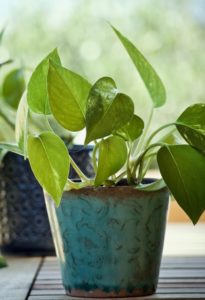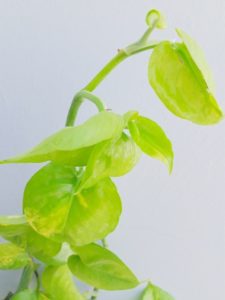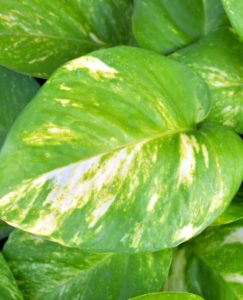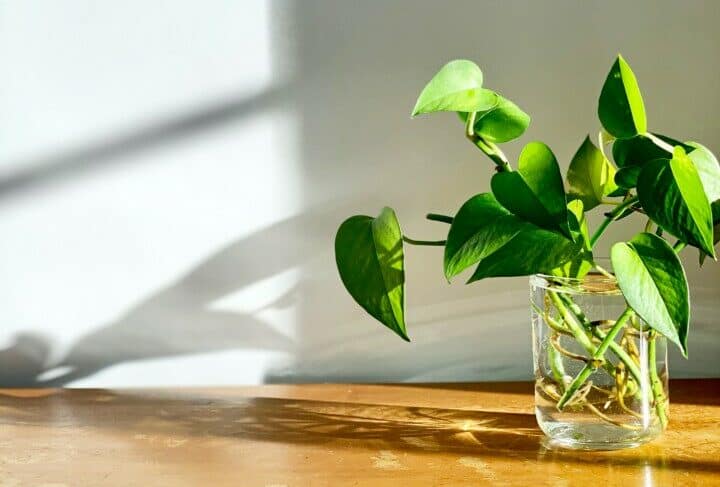Some links in the post are affiliate links and I get a commission from purchases made through some links found in the post.
A pothos plant is an evergreen and comes with green, heart-shaped foliage. It is impossible to look at and not get amazed by its beautiful leaves and unique look.
Pothos is native to the tropical environment, however, it is one of the most perfect houseplants. Pothos plant care is very easy and this low-maintenance plant does not require much.
Watering is an essential part of the health of every plant, including pothos. Pothos watering schedule is dependent on many factors, including the plant size, container type, soil, humidity level, and temperature.
Generally, watering a pothos is done every 1-2 weeks, however it is individual to each plant.
It is important to have a proper pothos watering schedule because this is one of the main factors that determine the well-being of the plant.
However, as already mentioned above, there are a lot of factors to consider. In this article, we will discuss the pothos watering schedule, tips, and how to make your plant happy.
How to Know When to Water a Pothos
 A pothos plant can tell you when it needs to be watered. For example, one of the first signs that can tell you the pothos’s watering needs is dried topsoil.
A pothos plant can tell you when it needs to be watered. For example, one of the first signs that can tell you the pothos’s watering needs is dried topsoil.
When the topsoil of your pothos dries out, you know it’s time to water it. If the soil is dry at this level of two inches from the top, it is typically an indication that your plant requires more water.
You may also put a moisture indicator in the soil to alert you to when to water your pothos. The easiest approach to keep your pothos from getting dry is to have a regular watering routine for each season.
Additionally, you can also check the drainage holes to check if your pothos needs watering. If the dirt appears dry, crumbly, or is falling out of the hole, it indicates that your plant requires water.
Drooping leaves are the first indicator that your pothos watering has been delayed. Generally, leaves begin to droop near the plant’s base first. The leaves will droop across the plant as it dries out further.
The yellow leaves of a Pothos indicate that it requires water. When the leaves droop, they might begin to dry out and become yellow. The chlorophyll in the leaves will evaporate, leaving them with a faded yellowish color.
Just like yellow leaves, the brown leaves also indicate that your pothos requires extra water. The leaves will become brown after they have drooped and gone yellow.
This indicates that the plant is extremely dry and requires thorough watering. The leaves normally turn brown first towards the base of the plant, although they might turn brown anywhere throughout the plant.
How to Water my Pothos from the Top
Pothos plants can be pretty sensitive to toxins. Therefore, it is always recommended to use water that is free of chloride and other chemicals.
Such water is tap water in most cases. It is best to use non-chlorinated or filtered water. Also, make sure not to give your plants too cold or too hot water. This tropical plant prefers room temperature water as well.
Pour water through the soil gently until it runs out the container’s bottom drainage hole onto your pot’s water collecting tray.
If your pothos container does not include a drainage hole, determining the optimum moisture level will be considerably more difficult.
Growing pothos in hanging baskets or clay pots with one or more drainage holes in the bottom is always a good idea.
Stop watering after the water flows out of the drainage hole and allow the liquid to thoroughly penetrate the soil. It should never overflow or pool on the soil’s surface, as this indicates inadequate drainage.
If the soil looks to be completely saturated, you may stop watering. After a few hours, you will notice changes in your plant and most likely, it will perk up.
If the soil still remains somewhat dry, add some more water until it flows out the drainage hole, then cease watering.
How to Bottom Water my Pothos
Water your pothos from the bottom up to prevent getting too much moisture on the leaves themselves. This will aid in the prevention of illness and fungal concerns.
When you choose the bottom watering as the pothos watering technique, you place your potted plant in a big yet shallow container.
It’s fantastic since it uniformly moistens the soil. Capillary action, which is caused by adhesive and cohesive forces, allows water to ascend through the soil.
What you need to do for bottom watering is to fill the container halfway and see how much water has been absorbed after 30 minutes.
Check the dampness of the soil with your finger. Remove the pot from the container after it reaches the soil reaches the required level of moisture. This may be repeated on the same schedule as when you water the plant from above.
How Often Should you Water a Pothos in Winter?
 In moderate indoor conditions, pothos plants tend to go into a dormant phase in late fall and early winter. They do not die and still continue growth since they are evergreen, but they do slow down and cuddle up.
In moderate indoor conditions, pothos plants tend to go into a dormant phase in late fall and early winter. They do not die and still continue growth since they are evergreen, but they do slow down and cuddle up.
During the winter, make sure to put the pothos plant away from the chilly window or door drafts, which can quickly dry them out and potentially inflict severe damage.
This is the most convenient for pothos care because they don’t require much maintenance.
Because of the reduced quantity of sunshine and heat, the pothos watering frequency may be reduced to once every two weeks.
This is the time to use room temperature water to avoid a cold shock to the plants. Additionally, there is a higher risk of overwatering in winter. This happens because the soil dries out much slower.
A rule of thumb is to allow the soil to dry up completely between waterings. When you poke your finger into the earth, it should feel dry.
When using a moisture meter to assess the moisture content of the soil, a result of 2-3 indicates that your pothos is ready for a drink.
Pothos plants also droop slightly when thirsty, which is a nice reminder if you forget to water them.
It is always recommended you listen to your plants instead of sticking to a watering schedule because many various circumstances might impact it.
How Often Should you Water a Pothos in Summer?
When your pothos plant “wakes up” in spring, it will crave more regular waterings.
Early spring growth is modest, but the pothos plant may get thirstier as it devotes more energy to new leaf growth. Keep an eye out for any wilting or sluggish leaf unfurling to ensure it is getting adequate water.
During this period, watering once a week is usually sufficient, although this generally depends on the environment within your home.
Avoid overwatering or misting pothos during the spring, when humidity can be very high and plants can be pretty active.
In the summer months, the temperature rises and the household gets warmer and brighter.
Especially in temperate areas, spring and summer periods are when pothos plants grow the most. Therefore, obviously, they will require more water than they do during other times of the year.
Less humidity brought on by a hotter temperature might increase the pothos plant’s evaporation.
In hotter months, you can use the “finger method” to check your pothos soil’s moisture level a few times per week, and water as necessary. As soon as you notice that the soil is dry, give some more hydration to your beloved plants.
Misting will result in preserving a specific area of humidity around the leaves to hasten new development and preserve the plant’s brilliant green appearance.
During the pothos watering in summer, you must account for the amount of water lost due to evaporation. During the summer months, it is recommended to water your pothos 2 to 3 times a week.
Unless you reside in really hot, low-humidity conditions, your plant should be alright. In such a scenario, you’ll need to increase your watering game.
Summer is the ideal season for the growth of new leaves. Pothos demands temperatures of 80° F and humidity levels of 70% or more.
If you’re having difficulties boosting the humidity in your home, a humidifier can provide great help in that case.
What are the Signs your Pothos is Overwatered?
 Overwatering is the worst enemy of pothos because it causes root rot. A number of fungal diseases, bacteria, and pests flourish in high-moisture, low-drainage environments and can produce root rot.
Overwatering is the worst enemy of pothos because it causes root rot. A number of fungal diseases, bacteria, and pests flourish in high-moisture, low-drainage environments and can produce root rot.
The most prevalent signs of pothos overwatering are:
- Yellowing leaves
- Falling or drooping leaves
- Black or mushy roots
- The bad odor emanating from the plant’s base
If you see any of these problems, immediately stop watering and examine the situation. Root rot can destroy a pothos plant if it progresses too far.
However, you should be able to save your plant in the early stages by uprooting it, trimming off the rotting sections, and transferring it to a new container in well-drained soil.
Mild Overwatering may be easily cured by allowing the soil to dry out.
However, the underlying core cause of the problem can be the soil that does not drain well, Pothos, like other tropical plants, dislikes having “wet feet.”
Soggy soil will eventually suffocate the plant by preventing the roots from breathing and getting essential oxygen.
It is always recommended to plant pothos in a well-drained soil mix which mainly includes perlite, peat moss, coco coir, and vermiculite.
What are the Signs your Pothos is Underwatered?
Underwatering is at the other extreme of the spectrum. Many people believe that pothos would “thrive on neglect,” but this is not the case.
The plant is tough but not even that much. Signs of underwatered pothos include
- Dry, brittle leaves,
- Parts of the leaves yellowing
- Crispy areas on the foliage
- Excessive wilting and limp leaves
- Powdery-dry soil
A deep, substantial amount of water is the cure for underwatering. Pothos plants respond fast to moisture and will bloom within an hour after being watered.
You may now cut off any brown or dead leaves and use the “finger check” approach to check the soil level on a regular basis.
Remember that pothos like just the top 2-3″ of soil to dry out between waterings. This does not imply that your plant should be completely neglected and parched all of the time.
A thirsty pothos will wilt visibly. Prolonged drought might cause the plant to grow slowly or even die.
Extra Watering Tips for your Pothos
- If your pothos has covered a large area in the pot, it will probably drain water quickly. Therefore, it is recommended to reschedule watering every 6 days or so. Additionally, it is also a sign that your plant needs a larger container.
- A container that is overly big might also be problematic. A 10″ pot, for example, is too large for newly grown pothos. In contrast to a small container problem, you will most likely need to water it less frequently but with more water. This will keep the soil wet for longer and allow the plant to absorb water gradually. However, if the container is too large for the plant, it raises the risk of root rot.
- Pothos does not appreciate damp roots, so make sure your soil combination can effectively drain water. Add more vermiculite to hold water for a longer amount of time. Vermiculite mineral is like a sponge, absorbs water. It allows the proper evaporation of water and keeps the soil wet at the root level.
- Because regular garden soil is too heavy, avoid using it. Because the water will remain on the soil’s surface layer. It can also suffocate the roots and create fungal problems.
- Pothos watering during the day, especially on warmer days, causes the water to evaporate faster and tit can not give the plants any benefits. Pothos watering should be done either in the very early morning or in the evening.
- Watering leaves, contrary to common perception, does not cause them to grow quicker. Indoor houseplants should not be watered on the leaves because it can clog stomata of the foliage and can cause the disruption of osmosis and plant respiration.
Final Thoughts
 Pothos watering brings a positive and nice feeling and the process can make both you and the plant happy. Pothos is an incredibly resilient plant vine that can thrive in a variety of conditions.
Pothos watering brings a positive and nice feeling and the process can make both you and the plant happy. Pothos is an incredibly resilient plant vine that can thrive in a variety of conditions.
However, if you want your plant to genuinely thrive and produce lush, green, glossy leaves, you must monitor its hydration levels.
Fortunately, it is very easy to discern whether pothos plants need to be watered or dried out. Pothos watering is relatively easy when you watch the plant and pay attention to what it requires.


